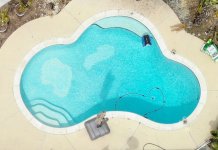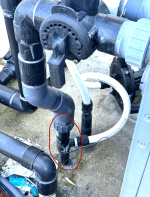Today: In ground plaster pool from roughly the 70s - lots of plaster issues, some patches failed and otherwise. Black algae. Approximately 12,000 gallons. San Francisco Bay Area. Roof top solar heating (a couple years old) w/ a new Pentair VSF pump and Pentair SolarTouch controller. PB4-60 Pressure side booster I installed myself last year. Polaris Quattro P40 Cleaner I just bought a month ago - so far I love this thing. Betta SE (2023 Model) that does a solid job.
Me: I'm not an idiot, I like DIY to an extent, but I also have a new baby. I've had pools basically my entire life but growing up, to be honest, I don't think my dad really knew what he was doing. I'm trying to take care of things myself but the chemical side I've not been doing great - working on it though. Last year I tried to hire a pool company and that was a total Darn show who left the pool in worse condition after 2 months then we started. And that was after they insisted we drain and refill the pool to get started.

Equipment Etc Photos
So finally... we're getting the pool remodeled: replacing the coping (to flagstone), new tile, and plaster with WetEdge Signature Matrix pebble finish. During that work, they're going to replace the skimmer (old and kind of busted), upgrade the main drain to split (code?), replace the light with LED, and add a safety fence.
All of that is fine and dandy, but my question is where to spend the money (if any) on equipment upgrades. They suggested:
I started reading about Hasa Liquid Feeder as a better alternative. Also I know that salt water and SWG's are a thing, but that maybe the cells are hard to get still? Also the Pentair IntelliChem has come up in my reading, more expensive than I might otherwise consider but if that ~$2k unit replace the $1600 UV thing, then it's not so bad. I'm trying not to drive my project costs up into the roof with equipment but if there are a few small tweaks I can make now - this seems like the most opertune time to do so.
Appreciate anyone/everyone input. Even the harsh lessons!
Me: I'm not an idiot, I like DIY to an extent, but I also have a new baby. I've had pools basically my entire life but growing up, to be honest, I don't think my dad really knew what he was doing. I'm trying to take care of things myself but the chemical side I've not been doing great - working on it though. Last year I tried to hire a pool company and that was a total Darn show who left the pool in worse condition after 2 months then we started. And that was after they insisted we drain and refill the pool to get started.

Equipment Etc Photos
So finally... we're getting the pool remodeled: replacing the coping (to flagstone), new tile, and plaster with WetEdge Signature Matrix pebble finish. During that work, they're going to replace the skimmer (old and kind of busted), upgrade the main drain to split (code?), replace the light with LED, and add a safety fence.
All of that is fine and dandy, but my question is where to spend the money (if any) on equipment upgrades. They suggested:
- Replacing my old Pentair CC2420 filter with a Jandy CL460 ($1700) - since I don't love the fiberglass dust I get on me everytime I get near that thing, seems like a good option.
- Bioshield UV Sanitizer ($1600) - The general sell on this is "Less chlorine required, less bad stuff in pool". Yes, I've read how TFP feels about the promises of less/no sanitizer. These things may work? They may be useful? They definitely aren't cheap to run due to replacement bulbs.
- Tab Feeder ($350) - The sales guy said that floaters aren't as good as a tab feeder. Can build up chlorine in one spot, yada yada.
I started reading about Hasa Liquid Feeder as a better alternative. Also I know that salt water and SWG's are a thing, but that maybe the cells are hard to get still? Also the Pentair IntelliChem has come up in my reading, more expensive than I might otherwise consider but if that ~$2k unit replace the $1600 UV thing, then it's not so bad. I'm trying not to drive my project costs up into the roof with equipment but if there are a few small tweaks I can make now - this seems like the most opertune time to do so.
Appreciate anyone/everyone input. Even the harsh lessons!
Last edited:


